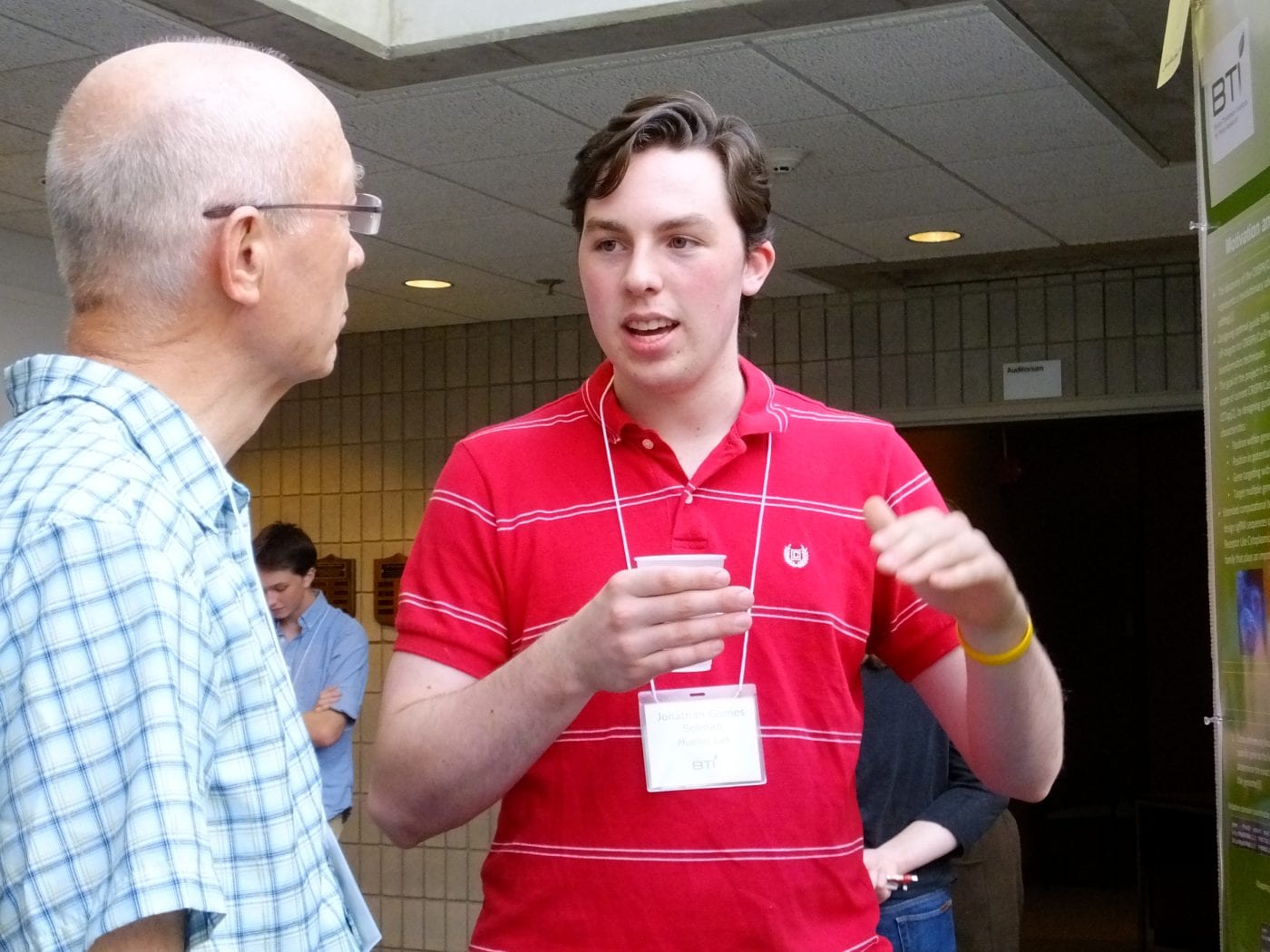News
Jonathan Gomes Selman Explores the Power of Computer Science

BTI Professor Klaus Apel listens to Jonathan Gomes Selman present his summer research poster, at Boyce Thompson Institute for Plant Research.
Three years ago, Ithaca high school senior Jonathan Gomes Selman wanted to get as far as possible from a career in computer science.
With both parents teaching computer science at Cornell University, the Ithaca native wanted to go in his own direction—maybe he would “rebel” and become a biologist or chemist. But as Gomes Selman realized the power of computing to solve problems in biology, chemistry and other fields, he’s come back around. As an intern in the 2015 Plant Genome Research Program (PGRP), he has used those skills to advance innovative plant bioinformatics research.
“I realized the extent that I can use computer science for all kinds of different things,” said Gomes Selman. “I like the idea of combining it with another field.”
A rising senior at Ithaca High School, Gomes Selman already had plenty of computer science experience before starting his internship. He completed an AP computer science class and one at Cornell. He also took a second-year Cornell course this summer, which ran concurrently with his BTI internship.
As a sophomore, he joined a school club that taught students how to create iPhone apps. He is now using that knowledge to make a citizen-science app called NY eBear, for a Cornell graduate student. The app will enable people to submit bear sightings for tracking bears throughout New York State to improve conservation efforts.
He believes that more schools should offer computer science classes and that have already begun to realize that coding and algorithmic thinking is an important and in-demand skill that students should experience before college.
Gomes Selman chose the PGRP internship over other options because it gave him the opportunity to explore a new field, bioinformatics: the use of software to make sense of biological data.
“I definitely made the right choice,” he said.
At BTI, he entered the laboratory of Associate Professor Lukas Mueller and worked with postdoctoral researcher Noe Fernandez. He set out to create a computer program to improve the efficiency of a genome editing technique called CRISPR/Cas9.
CRISPR technology is a promising new tool for editing DNA by making a double-stranded DNA cut at very precise points. A specially designed sequence, called a guide RNA, leads a cutting enzyme, called Cas9, to the location on the genome that a researcher wants to alter. The system can be used to edit and change specific parts of the genome, potentially allowing a researcher to control gene activity in an organism.
Since its discovery in 2012, web tools have popped up that can help scientists to design the best guide RNA to pinpoint the right location in the genome to snip, without making any other unwanted cuts. But in some cases, a researcher might want to edit several related genes that could have a redundant function. Gomes Selman is working on an approach that will design just a few guide RNAs to simultaneously target a whole family of genes.
“The websites are specifically designed right now to give you a guide RNA for targeting a single gene. So, I’m working on software to design guide RNA that will target several genes within a certain family,” he said. “If I can combine three different guides to silence 20, then that would be great.”
Gomes Selman has made good progress on his project, and was able to design multiple guide sequences for a gene family that plays an important role in plant immune responses called the Receptor Like Cytoplasmic Kinase (RLCK) family. One challenge of the internship is the relatively short six-week time frame. Gomes Selman will continue his work with the Mueller laboratory into the school year so that he can add further functionality to the guide RNA design software.
“I’ve grown to really enjoy coding and algorithm design to the point where I get sucked into it and I don’t want to stop,” he said.
“After the poster presentation at the PGRP student symposium, many people were interested in Jonathan’s project,” said his mentor, Fernandez. “They asked us if we will continue developing this software and if we could create a public web tool so that they could use it. It was great to work with Jonathan and I am looking forward to continuing this project with him.”
When he’s not coding, Gomes Selman plays varsity doubles tennis and enjoys playing saxophone and nature walks. For four years, he has also volunteered on the Ithaca Joint Youth Commission. The group offers summer programs and youth employment opportunities in the Ithaca area. His service on the commission inspired him to take advantage of available extracurricular activities, such as the NY eBear project, the BTI internship, and the Elephant Listening Project in the Bioacoustics Research Project at the Cornell Lab of Ornithology, which uses sound recordings to estimate elephant population numbers in Central Africa.
Gomes Selman is still exploring colleges but knows that he wants to attend a major research university to have many options for in-depth study and research. He has set his sights on pursuing a double major in computer science and another STEM field.
“I don’t know exactly if I’m headed towards biology, but the BTI internship has given me a true appreciation for research and for combining computer science with something like chemistry or biology,” he said. “I really enjoy all the science courses that I’ve taken. I’m going to take physics next year and, who knows, maybe I can do something with that as well.”

